N-3
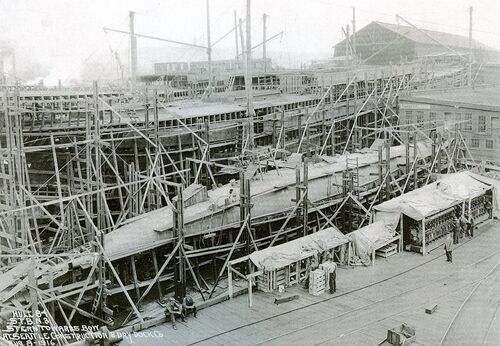
National Archives Seattle photo.

A closeup of the photo above, showing N-3's engines sitting on the construction slip, being prepared for installation. They had to be partially disassembled to be installed into the hull.
National Archives Seattle photo.
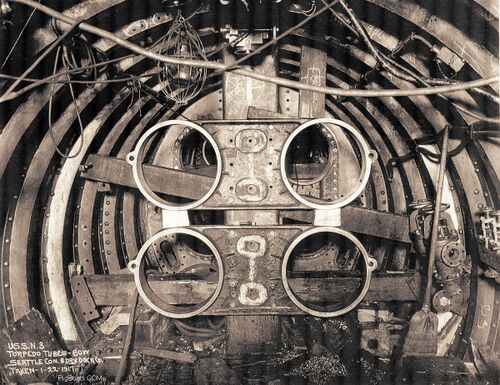
N-3 torpedo room under construction. The photo is taken January 22, 1917. From the many iron shavings on the deck you can see that much of the fabrication was done on site. These aren't really the torpedo tubes themselves just the bracing to hold the tubes in place. A number of air hoses and electrical wires are hanging from the overhead. A few rudimentary systems are beginning to be installed such as valve bodies and electrical outlets. A broom rests at the right side of the photo to keep the area somewhat tidy when needed.
National Archives Seattle photo.
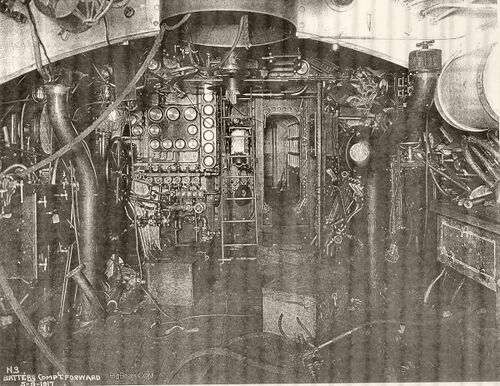
Control room of the N-3 while under construction. This view is actually from the after battery compartment looking forward into the control room. The watertight bulkhead that separates the two rooms has not yet been installed; a portion of it is visible at the top of the photo. With the bulkhead installed the control room was quite small. The control room looks to be pretty close to being finished. At the top center is a deck access hatch that opens into the fairwater superstructure aft of the bridge access trunk.
Seen at the far end is the ladder leading up into the conning tower. Between the two is a periscope housing with a rag stuffed up into it. Left of the ladder is the high pressure air manifold with its various pressures gauges and reducers. To the left of that are the bow and stern diving planes control wheels on the port side of the compartment.
The large pipe on the left is part of the battery well ventilation system to exhaust hydrogen gases. Another pipe is seen on the right side of the compartment. To the right of the door leading forward into the crew's quarters, seen at an angle, are ballast tank Kingston valve levers. Workmens tool boxes and various hoses are seen on the deck.
National Archives Seattle photo.

The engine room of the N-3 during construction. These engines were assembled and tested at the factory in New London and shipped by rail to Seattle where they were disassembled and lowered piece by piece into the hull through the square opening just behind the light, (with the wooden ladder in it). They were then reassembled in place. In these early years, building a submarine was very much like building a ship in a bottle. The keel would be laid first, then the frames were attached. The outer hull plating was then riveted to the frames. Gaps were left at the top of the plating for the installation of equipment.
High on the sides of the hull, over the engines, are the port and starboard exhaust valves waiting for the upper portions of the engines to be installed and the exhaust piping attached.
Clearly seen in the overhead are the drive rods for the rudders and stern planes. The rudder rod is to the left in the photo and the stern planes is on the right. Once the submarine is completed there are many installed items that make these harder to see. At the moment the compartment is pretty empty. The boards on top of the engines are to keep debris from falling into the cylinders and gives the workmen a place to stand without damaging anything.
National Archives Seattle photo.
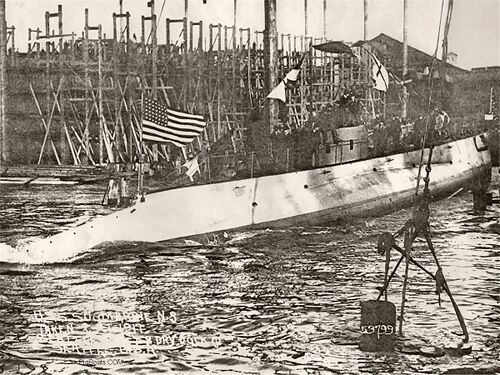
On February 21, 1917 the N-3 slides into the waters of Elliott Bay on the Seattle waterfront. On the decks are a mixture of yard workers and Navy personnel. A large surface craft is in the ways behind the N-3.
This shipyard had gone through several buyouts, ownership changes, and reorganizations since its founding in 1882. By the time of the photo it was called Todd Drydock & Construction Company. It would go through three more name changes and a major change in location to the present day. Originally located at the foot of Charles St. near the present day location of Lumen Field, it is now on Harbor Island off the Duwamish Waterway and is called Vigor Industrial Seattle.
National Archives Seattle photo.
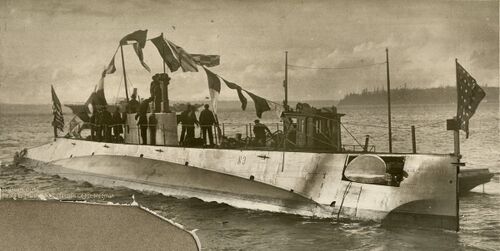
The N-3 just moments after her launch into Elliott Bay, Seattle with a small yard tug alongside to maneuver her to a dock.
In the background, on the right in the photo, is Magnolia Bluff, named by British Captain George Vancouver when he saw the huge madrona trees atop the peninsula's southern bluffs but mistook them for magnolias and noted this in the ship's log. The bluff had many madrona trees in bloom and looked like magnolias to him since he had never seen madrona trees before.
The land seen in the far background is Bainbridge Island. Named in 1841, by U.S. Navy Lieutenant Charles Wilkes on his visit to the island while surveying the northwest. LT Wilkes named the island after Commodore William Bainbridge, commander of the frigate USS Constitution in the War of 1812. A large private motor yacht is anchored in the bay behind the N-3.
Photo in the private collection of Ric Hedman.
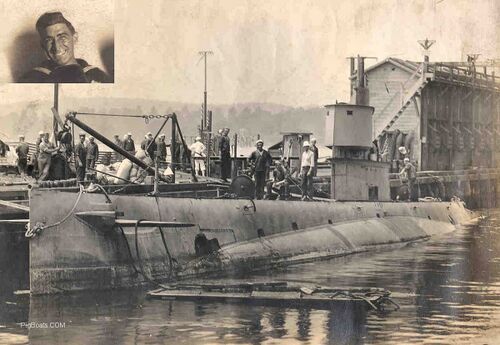
The N-3 seen here most likely July 24 or 25, 1918 after she was shelled by a British transport steamer while the submarine was making an anti U-boat patrol off the U.S. east coast. The shell hole can be seen just above the raft. Here is an account of what happened excerpted from "Beneath The Surface, World War I Submarines Built in Seattle and Vancouver" By Bill Lightfoot;
A note from the webmasters: this is a direct quote from the Lightfoot book. Disregard the reference to making a submerged patrol on one engine. This is not technically possible. It is a minor error by Lightfoot in an otherwise very informative book.
USS N-3 July 23, 1918 on patrol off Long Island.
Capt. of the N-3, Lt. Aquilla Gibbs Dibrell, Sr., of Tennessee, grandson of Confederate Gen. George Dibrell, kept the N-3 on this submerged, one engine, periscope patrol all that day except to make a midday altitude observations and wireless report. He came to the surface at 8:08 p.m. To have a seaman swim out to investigate what turned out to be two pilings floating upright. Midnight found the N-3 laying-to, 2500 ampere hours short of a full battery charge, having just started the port engine after failure that evening of both engines.
With the N-3 still laying-to on this night of full moon but hazy visibility, Dibrell suddenly detected, at 2:55 a.m., a steamer 800 yards to starboard. At nearly the same time Gunner's Mate Day reported a transport about 200 yards on the port quarter "headed right at us". Action became intense and confused. Ships seemed to be everywhere. The transport answered a green Very Pistol flare and flashlight recognition signals from the submarine with one long and three short blasts of the whistle, and with the order from the bridge, distinctly heard on the submarine,
"Fire!"
The flash of a six-incher at fifty yards. A shell penetrates N-THREE at the waterline. Attempting to maneuver. Engaging clutches. Shouting ship-to-ship. "Don't shoot, this is the N-THREE."
"Load!"
A flashlight pitifully lights up the American flag held aloft by two submariners. Other ships are glimpsed scattering in all directions.
Report from below: "Water coming in the torpedo compartment pretty fast." "Close watertight doors!" "Blow forward trim and adjusting tanks!" "Pump fuel overboard!"
"A destroyer looms into view," reported Capt. Dibrell. "I start to signal to request aid, but he is intent on ramming! At about twenty yards off I heard the officer on the bridge give 'hard right' and just as he grazed our bow 'hard left'."
By this time the surprised convoy is scattered, the dastardly transport out of sight, and the "friendly" destroyer, USS PREBLE Lieutenant Mack in command, has reversed its purpose and is standing by to be helpful. The surprised submarine is assessing damage. "Seventeen rivets sheered at the water line, frame no. 79 bent and twisted, hole in superstructure, anchor cable cut and anchor lost, forward diving rudder rod bent and knuckle joint sheered, torpedo expulsion tank dented, water standing to the combing in the torpedo compartment, wireless destroyed... We picked up a shell in our forward superstructure and found it to be British."
"At 4:30 a.m., having made temporary repairs, I proceeded on course 317 degrees for Block Island on port engine." In his report Dibrell went on to commend the action of his crew, "Every man on watch remained at his station,... there was no undue confusion or noise,. . . prompt action ... and good judgement shown by May (Chief Gunner's Mate R. D. May) undoubtedly prevented the forward battery compartment from being flooded..."
This photo seems to have been taken at Block Island since the background doesn't look like the New York Navy Yard.
The man shown in the inset is Machinist Mate 2nd Class William Brown. He is also seen standing just aft of the bow hatch with his hands on his hips and looking at the camera. According to MM 2c Brown's account to his son, mattresses were packed around the damaged area until better repairs could be made. Note the stack of seabags on the pier at the pier mounted boom.
Photo from the Private collection of Ken Brown whose father William M. Brown was aboard for this incident.
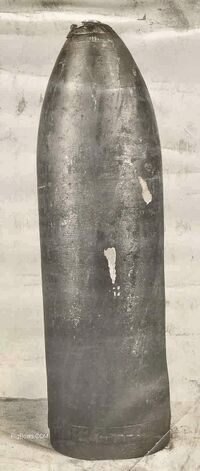
The 6" diameter British shell fired into the N-3's hull from 50 yards. It was found wedged into the forward superstructure below the main deck. Perhaps in haste the British crew failed to arm the fuse. If it had detonated it likely would have caused enough damage to sink the boat. The N-3 and her crew got very lucky that day.
Photo from the private collection of Ken Brown whose father William M. Brown was aboard for this incident.

William M. Brown served his country for 20 years in the U.S. Navy and was honorably discharged Aug 21, 1920 as Chief Machinist's Mate.
Photo from the private collection of Ken Brown whose father William M. Brown was aboard for this incident.
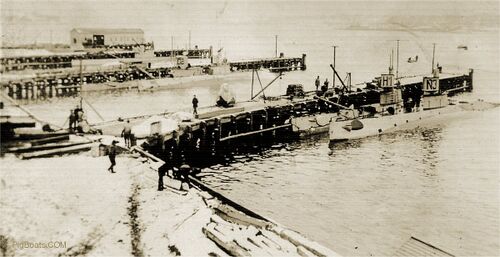
This waterfront photo was taken at Submarine Base New London, winter 1918-1919. Snow can be seen on the ground in the foreground of the photo. N-3 is outboard to the right. H-1 (Submarine No. 28) is between her and the pier. The next boat to the left is H-2 (Submarine No. 29), with G-2 (Submarine No. 27) inboard of her. The last boat to the left is the N-7 (Submarine No. 59).
Photo in the private collection of Ric Hedman.
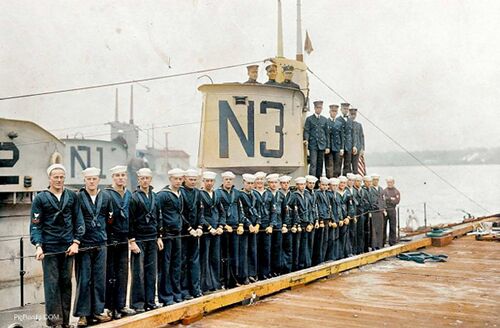
The Army had adopted this from the British and began authorizing them for American troops. Originally the Army sewed them, like the British, with the chevron legs pointing up. The Navy, upon adoption, sewed them with legs pointing down. This meant that the sailor had been deployed in the European Theater of Operations. If the stripe was sewn on the right sleeve it meant the person had been wounded due to enemy action. It was the equivalent to a Purple Heart and was later exchangeable for that medal and ribbon after 1937. This photo was colorized by Ric Hedman.
National Archives Photo

It is likely that the commanding officer is LT Francis Sanderson Craven in the middle of the front row. Names are still being researched for the other two. The back of the photo has the name "R. W. Nelson" written on it. Possibly one of the members of the crew. Without a crew list there is no way to know. This photo was colorized by Ric Hedman.
Photo in the private collection of Ric Hedman. Thanks to Wolfgang Hechler for the possible CO identification.
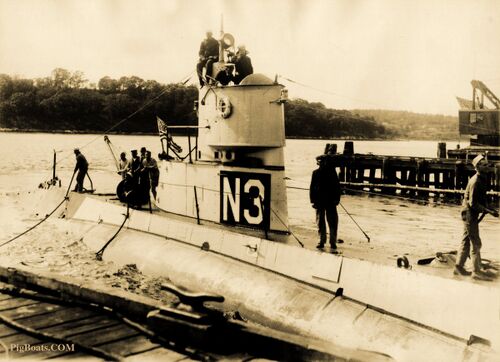
This photo shows the N-3 returning to the docks at Submarine Base New London on or around September 27, 1925 after assisting in operations to rescue the crew of the S-51 that had sunk with all hands. The S-51 had been rammed by the steamer SS City Of Rome on September 25, 1925.
Photo in the Private collection of Ric Hedman.
Page created by:
Ric Hedman & David Johnston
1999 - 2023 - PigBoats.COM©
Mountlake Terrace, WA, Norfolk, VA
webmaster at pigboats dot com
